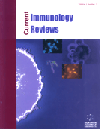- Home
- A-Z Publications
- Current Immunology Reviews (Discontinued)
- Previous Issues
- Volume 4, Issue 2, 2008
Current Immunology Reviews (Discontinued) - Volume 4, Issue 2, 2008
Volume 4, Issue 2, 2008
-
-
PROGRAMMED Cell Clearance: Molecular Mechanisms and Role in Autoimmune Disease, Chronic Inflammation, and Anti-Cancer Immune Responses
More LessAuthors: Erika Witasp, Valerian Kagan and Bengt FadeelDuring normal development and tissue turnover, cells are programmed to undergo apoptosis and cell corpses are subsequently removed by professional phagocytes (macrophages) or other neighboring cells. The recognition and engulfment of apoptotic cell corpses, a complex and dynamic process which we have termed programmed cell clearance, is thought to prevent chronic inflammation through the disposal of Read More
-
-
-
Leptin and Inflammation
More LessAuthors: Noriko Iikuni, Queenie L. Kwan Lam, Liwei Lu, Giuseppe Matarese and Antonio La CavaThe past few years of research on leptin have provided important information on the link between metabolism and immune homeostasis. Adipocytes influence not only the endocrine system but also the immune response through several cytokine-like mediators known as adipokines, which include leptin. It is widely accepted that leptin can directly link nutritional status and pro-inflammatory T helper 1 immune respons Read More
-
-
-
Inhibitory MHC Class I Receptors on Myeloid Cells
More LessAuthors: Akira Nakamura and Toshiyuki TakaiInhibitory MHC class I receptors are mainly expressed on NK cells. NK cells bear various kinds of inhibitory MHC class I receptors, Killer cell immunoglobulin (Ig)-like receptors, CD94/NKG2A hetrodimer, and murine Ly49 receptor family for monitoring the expression of MHC class I on surrounding cells. Leukocyte Ig-like receptors (LILRs), which bind MHC class I molecules, are expressed on other immune cells, such as B Read More
-
-
-
Immunoglobulin Free Light Chains in Immune Responses
More LessAuthors: Joris v. der Veeken and Frank A. RedegeldThe functional activity of immunoglobulin free light chains in mast cell-dependent hypersensitivity-like responses implicates a potential role for these molecules in other immune disorders. Mast cell-bound immunoglobulin free light chains recognize antigen and induce mast cell activation and mediator release. Through this mechanism, immunoglobulin free light chains can contribute to the pathogenesis of e.g. contact hyp Read More
-
-
-
Pleiotropic Roles of Runx Transcription Factors in the Differentiation and Function of T Lymphocytes
More LessAuthors: Kazuyoshi Kohu, Masato Kubo, Hitoshi Ichikawa, Shinichiro Ohno, Sonoko Habu, Takehito Sato and Masanobu SatakeThe proteins of the Runx gene family are among the most important transcription factors for regulating the differentiation and function of T lymphocytes. Runx1 and Runx3 are each involved in multiple and distinct steps throughout the process of T-cell differentiation. Targeted disruption or transgenic overexpression of the Runx genes causes pleiotropic and pathological phenotypes, including cell differentiation arrest, abn Read More
-
Volumes & issues
Most Read This Month
Article
content/journals/cir
Journal
10
5
false
en


